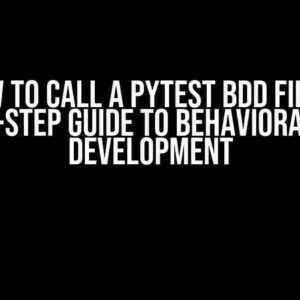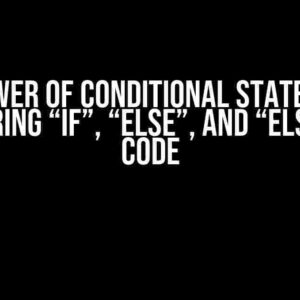PHP’s Object-Oriented Programming (OOP) paradigm is an essential tool for any serious developer, and at the heart of it lies the mighty object operator ->. In this comprehensive guide, we’ll delve into the world of PHP OOP, exploring what makes the object operator so powerful and how to harness its full potential. Buckle up, folks, and get ready to take your PHP skills to the next level!
What is PHP OOP?
Before we dive into the object operator, let’s quickly review what PHP OOP is all about. PHP OOP is a programming paradigm that revolves around the concept of objects and classes. In essence, it allows you to organize your code into logical groups, making it more modular, reusable, and maintainable.
In PHP OOP, a class represents a blueprint or template for creating objects. A class defines properties (data) and methods (functions) that can be used to manipulate and interact with objects. Objects, on the other hand, are instances of classes, each with their own set of attributes and behaviors.
The Object Operator ->
The object operator -> is a crucial part of PHP OOP. It’s used to access properties and methods of an object. Think of it as a magic wand that lets you tap into the inner workings of an object, retrieve its values, and invoke its methods.
<?php
class Person {
public $name;
public function sayHello() {
echo "Hello, my name is " . $this->name . "!";
}
}
$john = new Person();
$john->name = "John Doe";
$john->sayHello(); // Output: Hello, my name is John Doe!
?>
In the example above, we define a `Person` class with a `name` property and a `sayHello` method. We then create an instance of the class, assigning it to the `$john` variable. Using the object operator ->, we access and set the `name` property, and invoke the `sayHello` method.
Accessing Properties with ->
Accessing properties with the object operator -> is as simple as using the arrow symbol followed by the property name. For example:
<?php
class Car {
public $color;
public $model;
}
$myCar = new Car();
$myCar->color = "Red";
$myCar->model = "Toyota Camry";
echo $myCar->color . " " . $myCar->model; // Output: Red Toyota Camry
?>
Here, we access and set the `color` and `model` properties of the `$myCar` object using the object operator ->.
Invoking Methods with ->
Invoking methods with the object operator -> is similar to accessing properties. You simply use the arrow symbol followed by the method name, along with any required arguments. For example:
<?php
class Calculator {
public function add($a, $b) {
return $a + $b;
}
}
$calc = new Calculator();
$result = $calc->add(5, 3); // Output: 8
echo $result;
?>
In this example, we invoke the `add` method of the `$calc` object, passing in two arguments (5 and 3). The method returns the sum of the two numbers, which is then stored in the `$result` variable.
Understanding $this->
When working with classes and objects, you’ll often encounter the `$this` keyword. `$this` refers to the current object being executed. It’s used to access properties and methods within the object itself.
<?php
class Rectangle {
public $width;
public $height;
public function area() {
return $this->width * $this->height;
}
}
$rect = new Rectangle();
$rect->width = 5;
$rect->height = 10;
echo $rect->area(); // Output: 50
?>
In the example above, we use `$this` within the `area` method to access the `width` and `height` properties of the object. This allows us to calculate the area of the rectangle.
Common Pitfalls and Gotchas
While the object operator -> is a powerful tool, it can also lead to common mistakes and pitfalls. Here are a few things to watch out for:
- Null Object Reference: Be careful when accessing properties or methods on a null object. This can lead to PHP errors and notices.
- Property Visibility: Make sure to declare properties with the correct visibility (public, private, or protected) to avoid access issues.
- Method Overloading: Be cautious when using method overloading, as it can lead to unexpected behavior if not implemented correctly.
Best Practices and Conclusion
Mastering the object operator -> is a crucial step in becoming proficient with PHP OOP. By following best practices and understanding the intricacies of the object operator, you’ll be able to write more efficient, modular, and maintainable code.
Here are some final tips to keep in mind:
- Use descriptive class and property names to improve code readability.
- Document your code with clear, concise comments.
- Use coding standards and conventions to maintain consistency.
- Test your code thoroughly to ensure it works as expected.
| Best Practice | Description |
|---|---|
| Consistent naming conventions | Use consistent naming conventions for classes, properties, and methods. |
| Clear documentation | Document your code with clear, concise comments to improve readability. |
| Coding standards | Follow established coding standards and conventions to maintain consistency. |
| Thorough testing | Test your code thoroughly to ensure it works as expected and catch any errors. |
In conclusion, the object operator -> is a fundamental aspect of PHP OOP. By mastering its usage and understanding the intricacies of PHP OOP, you’ll be well on your way to becoming a proficient PHP developer.
Frequently Asked Question
Get ready to dive into the world of PHP OOP and object operators! Here are some frequently asked questions to help you navigate the landscape.
What is the purpose of the object operator (>) in PHP?
The object operator (>) in PHP is used to access the properties and methods of an object. It’s like a doorway to the object’s world, allowing you to interact with its members and get the desired output!
Can you use the object operator with static properties and methods in PHP?
No, you cannot use the object operator (>) with static properties and methods in PHP. Instead, you use the scope resolution operator (::) to access static members. It’s like a special key to unlock the static treasures!
What is the difference between the object operator (>) and the scope resolution operator (::) in PHP?
The object operator (>) is used to access instance members (non-static properties and methods), while the scope resolution operator (::) is used to access static members (static properties and methods) or to resolve class constants. Think of them as two specialized tools for different tasks!
Can you override an object’s properties and methods using the object operator (>) in PHP?
No, you cannot override an object’s properties and methods using the object operator (>) in PHP. Instead, you use inheritance and polymorphism to achieve this. It’s like building upon the foundation of the parent class to create something new and awesome!
Is the object operator (>) required to access public members of an object in PHP?
Yes, the object operator (>) is required to access public members of an object in PHP, even if you’re within the same class. It’s like knocking on the door of the object to ask for its public properties and methods!






